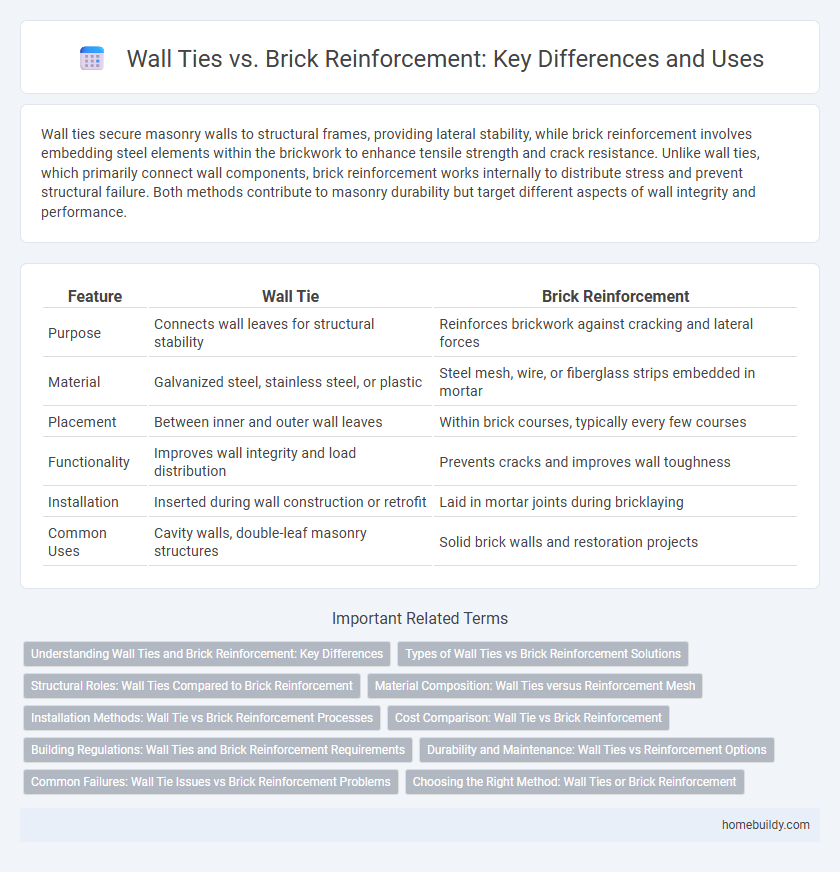Wall ties secure masonry walls to structural frames, providing lateral stability, while brick reinforcement involves embedding steel elements within the brickwork to enhance tensile strength and crack resistance. Unlike wall ties, which primarily connect wall components, brick reinforcement works internally to distribute stress and prevent structural failure. Both methods contribute to masonry durability but target different aspects of wall integrity and performance.
Table of Comparison
| Feature | Wall Tie | Brick Reinforcement |
|---|---|---|
| Purpose | Connects wall leaves for structural stability | Reinforces brickwork against cracking and lateral forces |
| Material | Galvanized steel, stainless steel, or plastic | Steel mesh, wire, or fiberglass strips embedded in mortar |
| Placement | Between inner and outer wall leaves | Within brick courses, typically every few courses |
| Functionality | Improves wall integrity and load distribution | Prevents cracks and improves wall toughness |
| Installation | Inserted during wall construction or retrofit | Laid in mortar joints during bricklaying |
| Common Uses | Cavity walls, double-leaf masonry structures | Solid brick walls and restoration projects |
Understanding Wall Ties and Brick Reinforcement: Key Differences
Wall ties are metal components used to connect the external brick veneer to the internal structural frame, providing stability and preventing separation due to lateral forces. Brick reinforcement involves embedding steel reinforcement bars or mesh within the mortar joints or masonry units to improve tensile strength and crack resistance. Unlike wall ties that primarily ensure connection between layers, brick reinforcement strengthens the masonry as a composite unit for enhanced durability.
Types of Wall Ties vs Brick Reinforcement Solutions
Wall ties are metal fasteners designed to connect the outer brickwork to the inner structural wall, ensuring stability and preventing separation, commonly available in stainless steel, galvanized steel, and plastic-coated varieties. Brick reinforcement involves installing steel rods, mesh, or wire within mortar joints to strengthen masonry walls against cracking and lateral forces. While wall ties primarily serve as connectors, brick reinforcement solutions provide enhanced structural integrity and durability, often combined in construction for optimal performance.
Structural Roles: Wall Ties Compared to Brick Reinforcement
Wall ties serve as critical connectors that anchor brickwork to structural frames, enhancing lateral stability and preventing wall separation under wind or seismic loads. Brick reinforcement primarily strengthens the masonry itself by distributing stresses and controlling crack propagation in the brickwork. Wall ties work synergistically with brick reinforcement, with ties providing connection and load transfer across the wall assembly while reinforcements improve the tensile strength within the brick components.
Material Composition: Wall Ties versus Reinforcement Mesh
Wall ties are typically made of galvanized steel or stainless steel to resist corrosion and ensure long-term stability between brickwork and structural frames. Reinforcement mesh, often composed of welded steel wires or galvanized steel, provides tensile strength distributed across masonry surfaces, enhancing overall wall integrity. The distinct material compositions impact their functions: wall ties primarily connect different wall components, while reinforcement mesh reinforces the brick structure against cracking and lateral forces.
Installation Methods: Wall Tie vs Brick Reinforcement Processes
Wall ties are installed by embedding metal strips into mortar joints to connect the outer brickwork to the inner frame, providing structural stability through mechanical fastening. Brick reinforcement involves placing wire mesh or reinforcement bars within mortar joints or laying them across entire sections of brickwork to enhance tensile strength and resist cracking. The wall tie process is typically faster and less labor-intensive, while brick reinforcement requires precise placement during construction for optimal performance.
Cost Comparison: Wall Tie vs Brick Reinforcement
Wall ties generally offer a more cost-effective solution compared to brick reinforcement due to lower material and installation expenses. Brick reinforcement requires additional labor and materials such as steel bars or mesh, which significantly increases overall project costs. Choosing wall ties can reduce budget allocation while maintaining structural stability in masonry construction.
Building Regulations: Wall Ties and Brick Reinforcement Requirements
Wall ties must comply with Building Regulations, specifically Approved Document A, ensuring structural stability by connecting masonry leaves and preventing wall separation. Brick reinforcement, governed by Part A and relevant standards such as BS EN 845-1, enhances masonry strength against lateral loads and crack propagation. Both elements require certification and installation following manufacturer guidelines to meet safety and durability standards mandated by current Building Regulations.
Durability and Maintenance: Wall Ties vs Reinforcement Options
Wall ties typically offer superior durability by providing consistent structural stability through corrosion-resistant materials like stainless steel or galvanized steel, minimizing long-term maintenance needs. Brick reinforcement often requires periodic inspection and repair due to potential mortar deterioration and less effective resistance to environmental stressors. Choosing wall ties enhances the lifespan of masonry walls by reducing the risk of cracking and displacement, ensuring lower maintenance costs over time.
Common Failures: Wall Tie Issues vs Brick Reinforcement Problems
Wall tie failures often involve corrosion, displacement, or inadequate embedment, leading to structural instability and wall separation. Brick reinforcement problems typically arise from cracking due to thermal expansion, poor mortar bonding, or insufficient reinforcement placement. Both issues compromise wall integrity, but corrosion predominates in wall ties while mechanical stress is more critical in brick reinforcement.
Choosing the Right Method: Wall Ties or Brick Reinforcement
Wall ties securely link the inner structural wall to the outer brickwork, enhancing stability and preventing separation, making them ideal for cavity wall construction. Brick reinforcement, involving the insertion of mesh or rods within mortar joints, improves the tensile strength and crack resistance of solid brick walls. Selecting between wall ties and brick reinforcement depends on wall type and structural requirements, with wall ties preferred for cavity walls and brick reinforcement suited for solid masonry needing enhanced durability.
Wall tie vs Brick reinforcement Infographic

 homebuildy.com
homebuildy.com